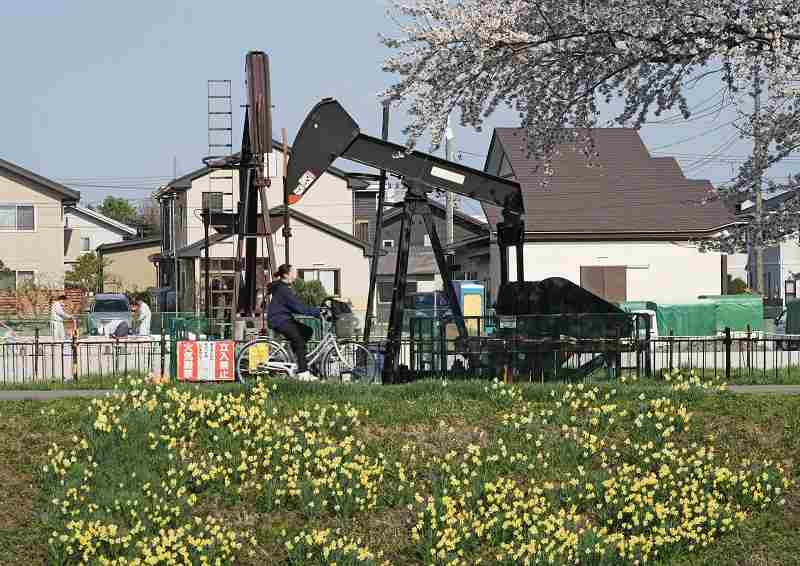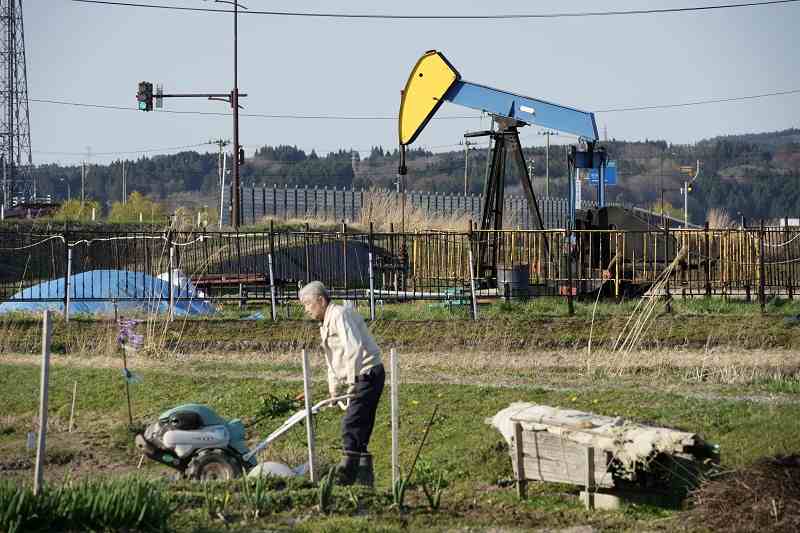
An oil pump is framed by trees and flowers in the Yabase district of Akita City.
6:57 JST, June 25, 2022
AKITA — Are you familiar with “drinking birds?” These small, birdlike novelty toys repeatedly dip their beak into a glass of water, using their bodies like a pendulum to swing back and forth. A scene from my long-past childhood involving a drinking bird is etched into my memory.
Recently, I happened to notice objects not dissimilar to the bird toys by the side of a road in Akita City. They seemed fairly large — even compared with the people passing by — and I quickly realized, of course, that they were not toys.
The more I looked, the more I saw such objects dotted around the area.
Using the internet to satiate my curiosity, I discovered that the “birds” were in fact pumps drawing up oil from the Yabase Oil Field. To satisfy my curiosity about their operation, I decided to take a closer look with map in hand.
What’s in a name?
Initially, I headed for the Yabase district, which is also close to The Yomiuri Shimbun’s Akita Bureau in the Sanno district in the city. It was very pleasant to walk along the river, and many other people were enjoying the same experience. As I walked a little further, I came across one of the pumps standing on a grass strip surrounded by fences in a corner of a quiet residential district. The pump was quiet and inactive.
The tree-lined waterway was the Kusozu River, thought to be named for the Japanese word for foul-smelling water. In bygone days, kusozu was a synonym for petroleum. The history of the petroleum business stretches far into the past: It is mentioned in a diary kept by a chief retainer of the feudal domain of Akita in the early 17th century, during the Edo period (1603-1867).
I discovered it is possible to take a closer look at the pump — now retired and used for display purposes — in a small park located nearby.
Japan’s ‘biggest oil field’
Strolling northward from the Yabase district, I headed for the Soto-Asahikawa district, which constitutes the upper reach of the Kusozu River. Here, at a spot near the central wholesale market in Akita, you will encounter a grand stone monument with an inscription that reads: “Japan’s biggest oil field originated here. The Yabase Oil Field dates to the early Meiji era [1868-1912]. It is Japan’s biggest oil field, thanks to the contributions made by many of our pioneering leaders … Its golden age spanned from 1946 to 1961.” Another sentence reads, “It produced as much as 90% of total domestic crude oil,” reflecting local pride in the oil field’s positive impact on Akita’s local economy in the postwar years.
Sadly, however, the oil field lost its crown to the Iwafune-Oki Oil and Gas Field, in waters off the coast of Tainai, Niigata Prefecture, when measured in terms of cumulative total output in fiscal 2020, 24 years after the stone monument was installed.
Many oil wells remain in the Soto-Asahikawa district, a great number of which are visible from the main road. Some can be found standing on corners at intersections or in residential districts, while others stand alone in farmland.
Working pumps can be seen in the Soto-Asahikawa district. Motor-like sounds can be heard while they operate, mixing with other sounds in the surrounding area. I was involuntarily fascinated by the way the pumps moved, reminding me of the humorous motions of the drinking birds.
New roles
To find out more about the present situation, I spoke with a manager at Inpex Corp., which operates the oil fields. Though 1,240 oil wells have been dug to date, only 20 now operate and pump crude oil. Daily output stands at about 25 kiloliters — annual production for fiscal 2020 totaled 9,118 kiloliters.
During their heyday, they boasted some 250,000 kiloliters of crude oil annually. Current output is tiny when compared with the nation’s total oil consumption.
Yet, the manager remains upbeat, saying: “[The pumps] have assumed new roles, such as helping in the development of technologies to purify the liquid that’s produced together with crude oil, and we use artificial intelligence to optimize their operations. These are some of the reasons we’d like to continue pumping oil for a long time.”
After hearing this, I revisited the pump on the corner of a residential district. As I looked at the “crude-oil-drinking bird,” nobly at work, I turned my thoughts to the changes that have occurred during Akita’s history.
Profile: Naruhiro Tanaka
Born in Setagaya Ward, Tokyo, in 1965. Joined The Yomiuri Shimbun as a photographer in 1989 and has worked in the field of photography ever since. Assumed current post in November 2020.
These days, he inadvertently sees things that remind him of the Showa era. Visiting places in Akita where traces of the era remain has become one of his pleasures.

A pump located on farmland in the Soto-Asahikawa district of Akita City.
"Society" POPULAR ARTICLE
-

M4.9 Earthquake Hits Tokyo, Neighboring Prefectures
-

Israeli Tourists Refused Accommodation at Hotel in Japan’s Nagano Pref., Prompting Protest by Israeli Embassy and Probe by Prefecture
-

M7.5 Earthquake Hits Northern Japan; Tsunami Waves Observed in Hokkaido, Aomori and Iwate Prefectures
-

Tsukiji Market Urges Tourists to Avoid Visiting in Year-End
-

M5.7 Earthquake Hits Japan’s Kumamoto Pref., Measuring Upper 5 Intensity, No Tsunami Expected
JN ACCESS RANKING
-

Tokyo Economic Security Forum to Hold Inaugural Meeting Amid Tense Global Environment
-

Keidanren Chairman Yoshinobu Tsutsui Visits Kashiwazaki-Kariwa Nuclear Power Plant; Inspects New Emergency Safety System
-

Imports of Rare Earths from China Facing Delays, May Be Caused by Deterioration of Japan-China Relations
-

University of Tokyo Professor Discusses Japanese Economic Security in Interview Ahead of Forum
-

Japan Pulls out of Vietnam Nuclear Project, Complicating Hanoi’s Power Plans






















